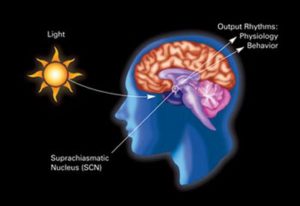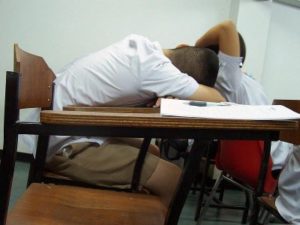Biological Clock

We have various metabolic processes within our bodies that are to some extent “clock-like” (i.e. repetitive and predictable – see the section on Clocks), e.g. heart beats, breathing, etc. But these processes are dependent on other conditions and stimuli, both internal and external, and are not reliably regular (e.g. heartbeats and breathing rates can speed or up slow down depending on our activities, health, environment, etc). But we do have some internal biological clocks that are much more reliable, autonomous and self-supporting, and one in particular is found throughout the natural world.
Circadian Clocks
Many essential biological processes and activities in living organisms observe more or less regular daily variations in their timing and duration (e.g. eating, sleeping, hormone production, cellular regeneration, etc, in animals; leaf movements, photosynthetic reactions, etc, in plants; etc). Humans,
and almost all life on Earth, from animals to plants to fungi, right down to single-celled organisms, have adapted themselves to the 24-hour light/dark day/night cycle of our planet.
Whether diurnal or nocturnal, the behavioural patterns of almost all life follow this daily cycle by means of a circadian clock, an endogenous (internal) time-keeper with a period of approximately 24 hours (the word “circadian” comes from the Latin words meaning “about a day”). Indeed, so similar is this mechanism throughout the spectrum of life, that it seems likely to have evolved from a single genetic code rather than through convergent evolution. Circadian clocks can be found even in primitive bacteria and other microbial organisms, and are among the evolutionarily oldest features of living organisms.
Interestingly, just like the artificial clocks we construct for our own timekeeping purposes, the basic mechanism of these biological clocks relies to a large extent on oscillation, using negative feedback loops, with hormones and neurons working in concert to achieve the required balance or homeostasis, and to prevent progress too far in one direction or another.
The circadian clocks of plants were first discovered in the 18th Century, and the great Swedish naturalist Carl Linnaeus designed a “floral clock” in 1751 on which the time was indicated by various flowers that bloomed at different times of the day. Photoperiodism, the physiological reaction of organisms to the length of day or night, is vital to both plants and animals, and the circadian system plays an important role in the measurement and interpretation of day length.
Suprachiasmatic Nuclei
In animals, the circadian clock is physically located in a tiny pinhead-sized area known as the suprachiasmatic nucleus in the hypothalamus region of the basal forebrain, one of the most evolutionarily ancient parts of the brain. There is one nucleus in each hemisphere of the brain, and so collectively they are referred to as the suprachiasmatic nuclei.
Although containing just 20,000 or so very small neurons, the suprachiasmatic nuclei are responsible for the overall circadian rhythms that the body perceives internally, and with regulating sleeping and feeding patterns, alertness, core body temperature, brain wave activity, hormone production (including melatonin and cortisol, which are so important in sleep regulation), glucose and insulin levels, urine production, cell regeneration, and many other biological activities. For instance, it maintains wakefulness by sending out alerting pulses throughout the day (to counteract the other element of our biological sleep regulation process, the homeostatic sleep pressure that gradually builds up during the day), and then weakens the alerting pulses and increases melatonin production in the late evening in order to open up the so-called “sleep gate”.
The circadian clock itself is adjusted or entrained to the environment by external cues, known as Zeitgebers (a German word meaning “time-givers”). The most important of these Zeitgebers is daylight and the daily light/dark cycle, information about which is transmitted to the suprachiasmatic nuclei via specialized ganglion cells in the eyes. The circadian clock uses these Zeitgebers to naturally synchronize or reset itself each day to within just a few minutes of the Earth’s 24-hour rotation cycle.
Interestingly, the individual neurons that make up the suprachiasmatic nuclei have been found to exhibit a near-24-hour rhythm of activity, suggesting that the clock mechanism actually works on a sub-cellular level. When dissociated from the brain, the individual cells follow their own intrinsic 24-hour rhythms, but, when incorporated into the suprachiasmatic nuclei, they all start to fire in perfect synchrony. In addition to this basic mechanism, the circadian rhythms of mammals are also encoded in a number of genes, including the PER or period gene, which work in complex interactions with the brain and the rest of the body.
In actual fact, individual circadian periods among humans do vary slightly, dependent on variations in the person’s PER gene, ranging between about 23.5 and 24.5 hours, with a mean of around 24.2 hours (just slightly more than the Earth’s rotation period). About 25% of people have a natural circadian period which is slightly less than the 24-hour day, and the other 75% have a circadian period slightly more than 24 hours. Individuals also have a chronotype, and some people (often known as “larks” or morning people) tend to wake up early and are most alert during the first part of the day, like many older people, while others (“night owls” or evening people) are most alert in the late evening and prefer to go to bed late, like many teenagers.
Peripheral Biological Clocks
There are also other secondary or peripheral biological clocks throughout the body, such as in the liver, heart, pancreas, kidneys, lungs, intestines, and even in the skin and lymphocytes, all of which show natural daily oscillations. Many of these secondary biological clocks are entrained independently by Zeitgebers like the timing of meals, ambient temperatures, exercise, etc, rather than by the light-dark cycle, but the central coordination and synchronization is still carried out by the suprachiasmatic nuclei.
Scientists working with mice have recently found evidence of a food-entrainable biological clock, which is not controlled by the suprachiasmatic nucleus. The exact location of this clock is still not clear, but it may be located in the dorsomedial hypothalamus area of the brain.
Still other cell clusters regulate shorter-period ultradian rhythms (cycles of less than a day), such as the 90-minute REM sleep cycle, the 4-hour nasal cycle, and the 3-hour cycle of growth hormone production. There are also infradian rhythms (cycles longer than a day), such as the monthly human menstrual cycle, and the annual migration, hibernation or reproduction cycles of certain animals and birds. Famously, some colonies of cicadas have a unique thirteen or seventeen year birth cycle.
Chronobiology

A whole field of study has arisen within biology in recent decades called chronobiology, which looks at, and seeks to use, the periodic or cyclic biological rhythms of living organisms and their adaptation to external rhythms and cycles. Scientists have realized that timing medical treatments to coincide with specific points in these cycles can enhance the effectiveness of the treatments.
The severity of many diseases often also varies across the 24-hour period, e.g. heart attacks occur most often in the morning, a few hours after waking up; temporal lobe epileptic seizures usually occur in the late afternoon or early evening; asthma is generally worst at night; etc. Understanding the biological basis of these changes across the day and night may provide an insight into the underlying cause of the diseases, and could lead to better therapy.
Perhaps the most obvious application of chronobiology is in the treatment of some sleep disorders, as well as temporary conditions like jet lag The use of light therapy and melatonin administration at specific times of day can be used as a means of resetting circadian rhythms, and thereby affecting sleep patterns. Other possible uses of chronobiological research are in the timing of the intake of calories and sodium in a person’s diet, and in the timing of drug and radiotherapy treatments.